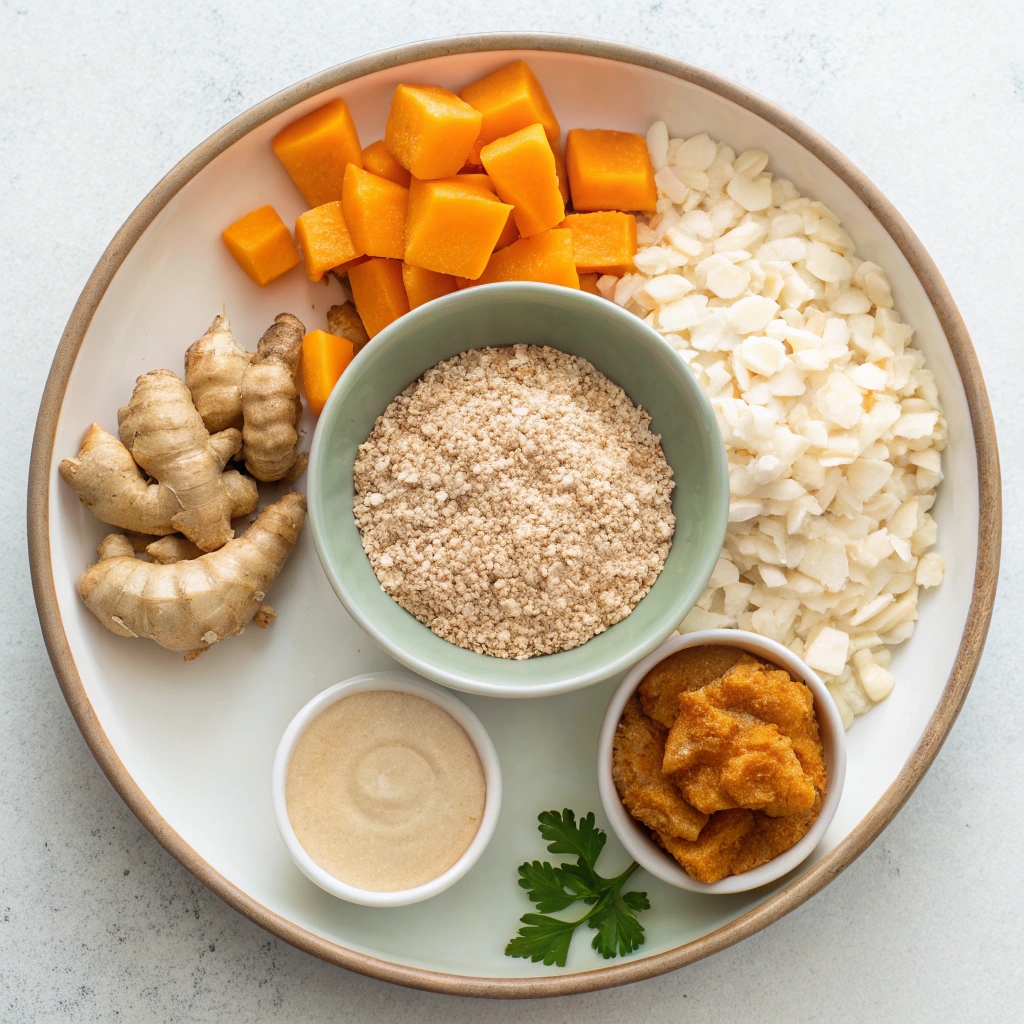Whole Oat Porridge is the ultimate cozy breakfast, blending creamy textures with a nutty, wholesome flavor in just 30 minutes.
This hearty dish is packed with fiber and nutrients, keeping you energized all morning. The oats soften to perfection, creating a velvety base that’s both comforting and satisfying. A touch of sweetness or a sprinkle of cinnamon can elevate it to pure morning bliss.
With only 10 minutes of prep and 20 minutes of cooking, this porridge is a fuss-free way to start your day.
Its versatility allows for endless toppings—fresh fruit, nuts, or a drizzle of honey—making each bowl uniquely delicious. Warm, nourishing, and effortlessly simple, it’s a breakfast that feels like a hug in a bowl.
Ingredients for Whole Oat Porridge & Variations

- Base Recipe:
- 1 cup whole oat groats (soaked overnight*)
- 4 cups filtered water
- Pinch of sea salt
- Butternut Squash & Ginger Variation:
- 3 ½ cups cubed butternut squash
- 1 tablespoon tamari (plus more for serving)
- 4 teaspoons grated fresh ginger
- ½ garlic clove, grated
- For serving: scallions, toasted pepitas, parsley, toasted sesame oil
- Miso & Avocado Variation:
- 1 tablespoon white miso paste
- For serving: avocado, tamari, scallions, sesame seeds, microgreens
Step-by-Step Instructions
- For the Base Recipe:
- Drain and rinse the soaked oat groats. Transfer them to a blender.
- Add 4 cups of fresh water and a pinch of salt. Pulse until the grains are coarsely ground.
- Pour the mixture into a medium pot and bring to a boil over high heat, whisking frequently.
- Cover the pot, reduce the heat to low, and simmer for 30 minutes. Stir occasionally to prevent sticking, until the grains are soft and the porridge is creamy.
- Serve hot with your desired toppings.
- For the Butternut Squash & Ginger Variation:
- Follow the base recipe instructions, adding the cubed butternut squash, grated ginger, and garlic to the pot along with the oat mixture.
- Cook as directed until the porridge is creamy and the squash is soft.
- Add 1 tablespoon of tamari and adjust seasoning to taste.
- Garnish with scallions, toasted pepitas, parsley, and serve with sesame oil and additional tamari for drizzling.
- For the Miso & Avocado Variation:
- Follow the base recipe instructions. Once the porridge has thickened, turn off the heat.
- Stir in 1 tablespoon of white miso paste until it’s fully dissolved.
- If the porridge becomes thinner, continue stirring over low heat until it thickens again, about 15-20 minutes.
- Serve with sliced avocado, tamari, scallions, sesame seeds, and microgreens.
Creative Toppings to Elevate Your Porridge
Transform your Whole Oat Porridge into a customizable breakfast or snack with these topping ideas. For a sweet twist, try fresh berries, a drizzle of honey, or a sprinkle of cinnamon.
If you prefer savory, add a poached egg, crumbled feta, or a dollop of pesto. Don’t forget nuts and seeds like almonds, chia seeds, or toasted coconut for added crunch and nutrition!
How to Store and Reheat Like a Pro
Store leftover porridge in an airtight container in the fridge for up to 3 days. To reheat, add a splash of water or milk to loosen the texture, then warm it on the stovetop over medium heat, stirring occasionally. For a quick fix, microwave it in 30-second intervals, stirring in between, until heated through.
Time-Saving Tips for Busy Mornings
Soak your oat groats overnight to cut down on cooking time. If you’re in a rush, use a pressure cooker or Instant Pot to cook the porridge in just 10 minutes. Alternatively, make a big batch on the weekend and reheat portions throughout the week for a hassle-free breakfast.
Equipment You’ll Need for Perfect Porridge
A high-speed blender is essential for coarsely grinding the oat groats. Use a medium-sized pot with a tight-fitting lid to simmer the porridge evenly. A whisk or wooden spoon will help prevent sticking, and a fine grater is perfect for fresh ginger and garlic in the variations.
Common Questions Answered
Can I use rolled oats instead of oat groats? Yes, but the texture will be smoother and the cooking time shorter. Is this recipe gluten-free?
Oats are naturally gluten-free, but ensure your oat groats are certified gluten-free if you have celiac disease. Can I make this vegan? Absolutely! Just skip any non-vegan toppings and stick to plant-based options.

Whole Oat Porridge
Ingredients
Method
- For the Whole Oat Porridge (base recipe): Drain and rinse the oat groats and transfer them to a blender. Add 4 cups fresh water salt and pulse until the grains are coarsely ground. Pour into a medium pot and bring to a boil over high heat, whisking frequently. Cover the pot, reduce the heat to low, and simmer for 30 minutes, stirring occasionally to prevent sticking, until the grains are soft and the porridge is creamy. Serve hot, with desired toppings.
- For the Butternut Squash & Ginger Variation: Follow the directions for the oat porridge recipe above, adding the squash, ginger, and garlic to the pot along with the oat mixture and cook as directed until the porridge is creamy and the squash is soft. Add the tamari and adjust the seasoning to taste. Garnish with scallions, pepitas, parsley, and serve with sesame oil and tamari, for drizzling.
- For the Miso & Avocado Variation: Follow the directions for the oat porridge recipe above. Once your porridge has thickened, turn the heat off and stir the miso paste into the hot porridge until it’s dissolved. If your porridge becomes thinner at this point (like mine did), continue stirring over low heat until it thickens, 15 to 20 minutes. Serve with sliced avocado, tamari, scallions, sesame seeds, and microgreens.
